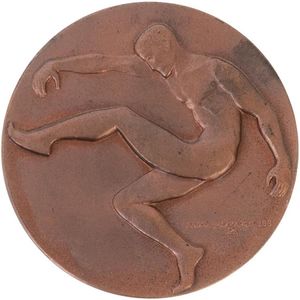1883 Seth Thomas Garfield Clock - Weight Driven Movement
You must be a subscriber, and be logged in to view price and dealer details.
Subscribe Now to view actual auction price for this item
When you subscribe, you have the option of setting the currency in which to display prices to $Au, $US, $NZ or Stg.
- Damascene - Damascening is a technique used to decorate metal objects, such as swords, armor, and other metalwork, by inlaying different colored metals into grooves that have been etched or engraved into the surface of the metal. The technique is believed to have originated in Damascus, Syria, and was later adopted by other cultures such as the Japanese, Indians and Iranians.
The process typically involves etching a design into the surface of the metal, and then filling the grooves with a contrasting metal, such as gold or silver. The inlaid metal is then burnished to create a smooth surface, and the design is polished to a high shine. Damascening can create intricate and highly detailed designs, and is often used to decorate weapons, as well as jewellery, and other decorative objects. - Pendulum - The pendulum was discovered around 1602 by Galileo Galilei, and was adopted for time keeping by the Dutch mathematician and natural philosopher, Christiaan Huygens, who excelled in astronomy, physics, and horology.
The pendulum comprises a metal rod usually of brass or steel with a metal disk, known as a bob, at the end. The movement of the pendulum is driven by weights or a spring, and as a pendulum swings in a regular arc, it was found accuracy could be controlled to within a few seconds a week.
Timekeeping can be adjusted by changing the height of the bob on the rod, making the pendulum either swing slower or faster.
The disadvantage of the pendulum was that changes in temperature also changed the length of the pendulum, interfering with the accuracy of the clock, and so in the 18th century two types of mercurial pendulums were invented which countered the movement in the steel rod.
The pendulum was the world's most accurate timekeeping technology until the invention of the quartz clock, regulated by a quartz crystal, in 1927. - Circa - A Latin term meaning 'about', often used in the antique trade to give an approximate date for the piece, usually considered to be five years on either side of the circa year. Thus, circa 1900 means the piece was made about 1900, probably between 1895 and 1905. The expression is sometimes abbreviated to c.1900.
- Movement - The technical name for the workings of a clock or watch, and does not include the dial or case.
This item has been included into following indexes:
Visually similar items

1979 Carlton Premiership Medal, front design of a footballer by Andor Meszaros (1900-72), reverse shows players names in their positions, surrounded by text 'Victorian Football League/Carlton: Premiers: 1979'. Together with perspex display stand engraved '

An Italian resin modular chaise, circa 1970

An Australian 9ct yellow gold opal, heart bar brooch two round opal doublets measuring 4.5 mm, with a heart and leaf design, made by Arthur Cocks & Co, Sydney

1920's blackwood wooden comport
